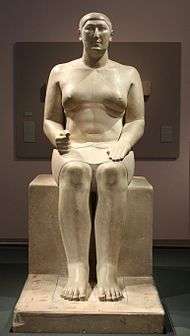Hemiunu
| Hemiunu | |||||
|---|---|---|---|---|---|
 Statue of Hemiunu at the Pelizaeus Museum, Hildesheim, Germany. His feet rest on columns of hieroglyphs, painted in yellow, red, brown, and black. | |||||
| Native name |
Hm-ỉwnw Priest of Iunu | ||||
| Occupation |
Vizier Architect Priest | ||||
| Title | Prince of Egypt | ||||
| Parent(s) | Nefermaat and Itet | ||||
Hemiunu (fl. 2570 BC) is believed to be the architect of the Great Pyramid of Giza, Egypt.[1][2] As vizier, Hemiunu was one of the most important members of the court and responsible for all the royal works. His tomb lies close to Khufu's pyramid.
Biography
Hemiunu was a son of Prince Nefermaat and his wife Itet,[3] a grandson of Sneferu and relative of Khufu, the Old Kingdom pharaoh. Hemiunu had three sisters and many brothers.
In his tomb he is described as a hereditary prince, count, sealer of the king of Lower Egypt (jrj-pat HAtj-a xtmw-bjtj) and on a statue found in his serdab (and now located in Hildesheim), Hemiunu is given the titles: king's son of his body, chief justice and vizier, greatest of the five of the House of Thoth (sA nswt n XT=f tAjtj sAb TAtj wr djw pr-DHwtj).[4]
As Vizier he succeeded Kanefer, his uncle, and his father Nefermaat.[5]
Tomb
Hemiunu's tomb lies close to Khufu's pyramid, and contains reliefs of his image. Some stones of his badly damaged mastaba (G4000) are marked with dates referring to Khufu's reign.[6] His statue[7] can be found at the Pelizaeus Museum, Hildesheim, Germany.[3] This statue is scheduled to be loaned for the opening of the Grand Egyptian Museum (as of August 2016 the Egyptian Museum has not yet been opened, and the statue is still on display in Hildesheim).
The statue was found in the walled-up serdab of Hemiunu's mastaba by archaeologist Hermann Junker in March 1912. Ancient looters had ransacked the mastaba in their quest for valuable items and the wall to the serbad had a child-sized hole cut into it. The robber forcefully gouged out the statue's precious inlaid eyes and gold castings, in the process the right arm was broken and the head severed. The head has been restored,[8] using a relief of Hemiunu as a guide for the nose's profile.
The seated statue is well-preserved apart from the damage mentioned above and is notable for its unusual realism, with Hemiunu's features only lightly stylized, and clearly based on his actual appearance. His unidealized body is frankly shown as flabby, with a notable accumulation of fat in the pectoral region. This contrasts with the more usual virile representation of male subjects in royal portraiture in this and most succeeding periods of Ancient Egyptian art.
Notes
- ↑ De Camp, p. 35
- ↑ Shaw, p. 89
- 1 2 Arnold, p. 107
- ↑ "Archived copy". Archived from the original on 2008-10-11. Retrieved 2010-09-11. page about G 4000, the tomb of Hemiunu
- ↑ Cambridge, p. 166
- ↑ Strudwick, p. 157
- ↑ Tiradritti, p. 13
- ↑ N.Y.), Metropolitan Museum of Art (New York (1999). Egyptian Art in the Age of the Pyramids. Metropolitan Museum of Art. ISBN 9780870999079.
References
- Dieter Arnold, The Encyclopaedia of Ancient Egyptian Architecture, I.B.Tauris, 2002
- Nigel C. Strudwick, Texts from the Pyramid, SBL, 2005
- Cambridge Ancient History by Cambridge University Press, 2000
- Francesco Tiradritti, Arte egizia, Giunti, 2002
- Lyon Sprague De Camp, Catherine Crook De Camp, Ancient Ruins and Archaeology, Doubleday, 1964
- Ian Shaw, The Oxford History of Ancient Egypt, Oxford University Press, 2003
External links

Coordinates: 29°58′46″N 31°07′48″E / 29.97944°N 31.13000°E